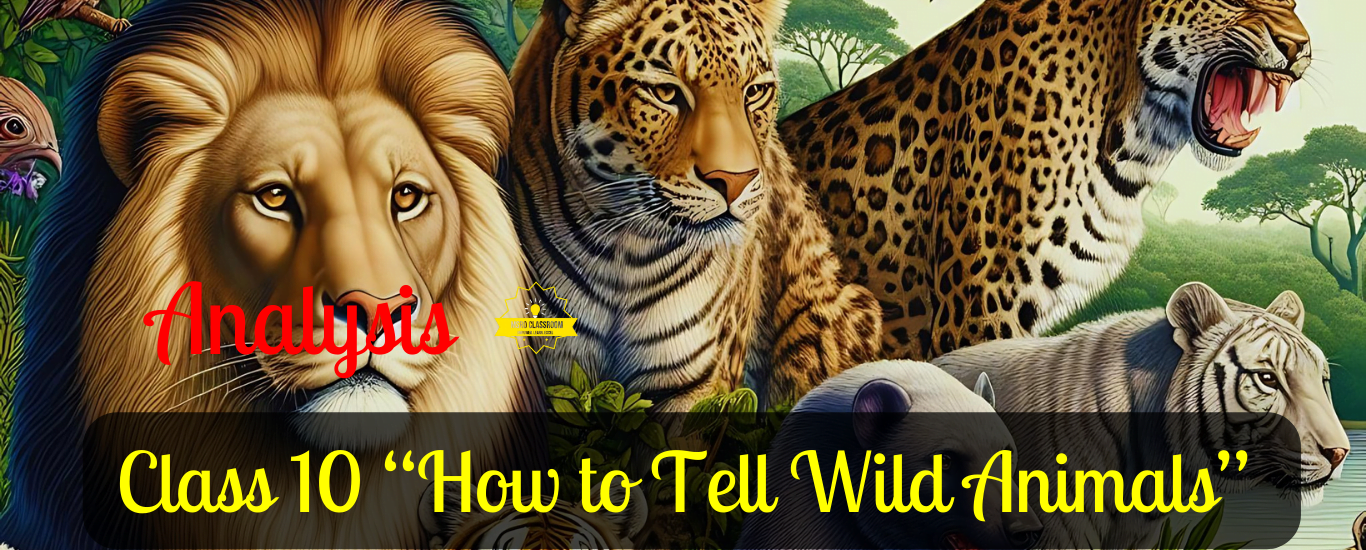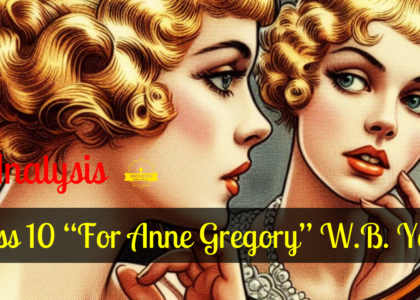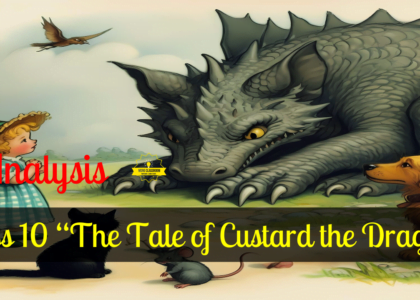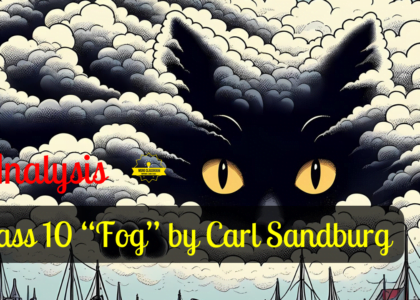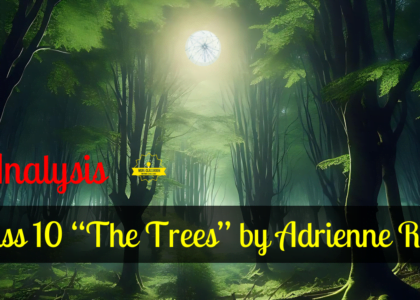Poem 4, Carolyn Well’s ‘How to Tell Wild Animals’ Summary, Theme, Analysis, Line-by-Line Explanation, Literary Devices, Textbook Exercises and Extract Based Questions.
Poem 4- How to Tell Wild Animals by Carolyn Wells:
Carolyn Wells
Carolyn Wells (1862-1942) was a prolific American author, poet, and writer of mystery novels, best known for her humorous and light-hearted verse. Wells’ works often featured playful wordplay, humorous rhymes, and charming narratives that appealed to a broad audience.
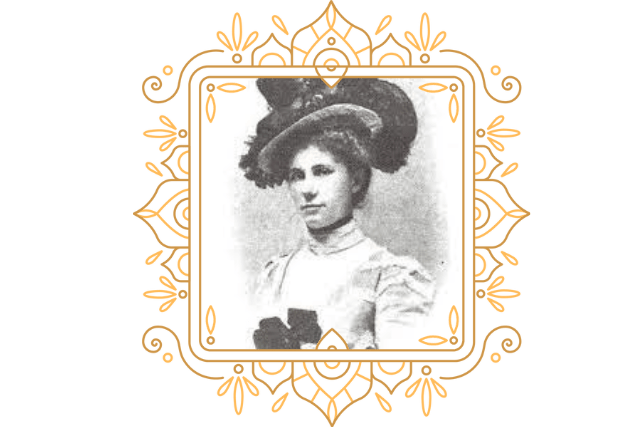
Table of Contents
Next on First Flight: Poem 5-‘The Ball Poem‘ by John Berryman, Chapter 4- ‘From the Diary of Anne Frank‘
Summary “How to Tell Wild Animals”:
In Carolyn Wells’ poem ‘How to Tell Wild Animals,’ the speaker offers whimsical and humorous advice on how to identify various wild animals based on their distinctive characteristics and behaviours. The poem playfully describes encounters with animals in the jungle and offers comical guidelines for recognising them. The poem covers the Asian Lion, Bengal Tiger, Leopard, Bear, Crocodile, Hyena, and Chameleon. Each animal is depicted in a humorous and often absurd manner, making the poem a lighthearted exploration of the animal kingdom.
The poem’s tone is whimsical and tongue-in-cheek, emphasising entertainment and amusement as readers learn these humorous ways to identify wild creatures. The poem uses wit and satire to offer amusing advice for distinguishing wild animals, turning the potentially serious subject matter into a delightful and entertaining read.
Central Idea: How to Tell Wild Animals:
The central idea of “How to Tell Wild Animals” revolves around humorously providing simple yet effective methods to distinguish various wild animals encountered in different settings. Carolyn Wells employs clever wordplay and rhyme schemes to create a lighthearted guide. Through playful descriptions and scenarios, she highlights key characteristics of animals such as the lion, tiger, leopard, bear, crocodile, hyena, and chameleon.
The poem blends entertainment with practical knowledge, emphasising the importance of observation and recognition in the face of potentially dangerous encounters while maintaining a humorous tone. It offers a whimsical yet informative exploration of wildlife identification.
Justification of the Poem’s Title:
The title “How to Tell Wild Animals” is aptly justified by the poem’s content, which provides humorous yet instructive guidance on identifying wild creatures based on their unique characteristics and behaviours. Through witty rhymes and playful descriptions, Carolyn Wells offers readers a lighthearted yet practical lesson in animal recognition, focusing on jungle-dwelling beasts like lions, tigers, leopards, bears, crocodiles, hyenas, and chameleons.
Each stanza of the poem presents a different animal along with distinct traits or actions that help differentiate it from others. By engagingly imparting this knowledge, the poem effectively serves as a whimsical field guide for distinguishing wild animals, hence justifying its title as a humorous yet educational manual for identifying creatures of the wild.
Explanation “How to Tell Wild Animals”:
‘How to Tell Wild Animals’ by Carolyn Wells is a whimsical and humorous poem that playfully provides tips on identifying various wild animals. Here is a more in-depth explanation of each stanza:
Stanza 1: The poem begins by addressing a hypothetical situation. If you find yourself in the jungles of the East and encounter a giant, tawny beast that roars, you should identify it as the Asian Lion. The poem sets the tone for its humorous and instructive style.
Stanza 2: The second stanza introduces the Bengal Tiger. It advises that if you encounter a wild beast with black stripes on a yellow background and it tries to eat you, you can be sure it’s a Bengal Tiger. The stanza uses a humorous twist to convey the tiger’s dangerous nature.
Stanza 3: Moving on, the poem describes the Leopard. If you encounter a creature with spots on its hide and it repeatedly leaps on you, it’s unmistakably a Leopard. The humour here lies in the idea that the leopard doesn’t just attack once but keeps leaping.
Stanza 4: The stanza introduces the Bear. It humorously suggests that if a creature in your yard hugs you tightly, it’s undoubtedly a Bear. The mention of the bear giving “just one more caress” adds a touch of dark humour to the description.
Stanza 5:
The poem discusses differentiating between the Crocodile and the Hyena. Hyenas are described as having merry smiles, while Crocodiles are noted for their tears. This is a playful way to distinguish these two animals, even though their characteristics differ.
Stanza 6: The final stanza concerns the Chameleon, a small lizard. It mentions that chameleons lack ears and wings and are typically found on trees. The humour here comes from the simplicity of identifying this relatively harmless creature compared to the more dangerous animals mentioned earlier.
To summarise, Carolyn Wells uses humour, wordplay, and clever descriptions to make identifying wild animals entertaining and amusing. The poem takes a satirical approach to the seriousness of wildlife identification, creating a fun and memorable verse.
How to Tell Wild Animals Analysis:
Carolyn Wells’ poem ‘How to Tell Wild Animals’ is a playful and humorous exploration of different wild animals and how to distinguish them based on their characteristics and behaviours. The poem is divided into several stanzas, each focusing on a specific animal, and it employs rhyming couplets to convey its lighthearted tone.
- Asian Lion: The poem starts with the Asian Lion. It suggests that if you encounter a large and tawny beast in the jungle that roars at you, it’s likely an Asian Lion. This sets the tone for the poem’s witty and whimsical approach to identifying wild animals.
- Bengal Tiger: The second stanza introduces the Bengal Tiger, characterised by black stripes on a yellow background. The humour lies in the idea that you’ll only be sure it’s a Bengal Tiger if it eats you, which is an absurd and impractical way to identify an animal.
- Leopard: The third stanza playfully describes the Leopard, which has spots on its hide. The repetition of “lep” in “lep on you” emphasises the leopard’s leaping ability, creating a whimsical image.
- Bear: The fourth stanza focuses on the Bear, emphasising its hugging behaviour. The humour comes from the idea that if you doubt whether it’s a bear, it will provide further clarification by giving you one more “caress.”
- Crocodile and Hyena: The fifth stanza humorously contrasts the Crocodile with the Hyena. It suggests that while Hyenas may appear with merry smiles, Crocodiles are identified when they weep. This twist adds a comical element to the poem.
- Chameleon: The final stanza introduces the Chameleon, emphasising its small size and peculiar characteristics, such as its lack of ears and wings. The Chameleon’s ability to blend in with its surroundings is humorously noted by saying that if there’s nothing on the tree, it’s probably the Chameleon.
Tone:
The tone of the poem is light-hearted and whimsical. It approaches identifying wild animals with a sense of humour, making it entertaining for readers. The poet uses clever wordplay and absurd situations to create a comical atmosphere.
Type:
This poem falls under the category of light or humorous poetry. It does not aim to provide profound information about wild animals but uses exaggeration and satire to amuse the reader.
Structure:
Rhyme Scheme- ABABCC (This particular Rhyme Scheme is known as Sesta Rima)
The poem consists of stanzas addressing a different wild animal. In each stanza, the poet presents a scenario or characteristic of the animal comically and exaggeratedly. The poem uses rhyme and rhythm to maintain a playful flow, making it easy to read and enjoy.
The poem employs a repetitive structure in each stanza’s last line, which helps build humour and anticipation as readers expect an unexpected twist or description of the animal. The poem is structured to engage the reader’s imagination and sense of humour.
Themes “How to Tell Wild Animals”:
- Nature and Wildlife Observation: The poem encourages the reader to pay attention to the characteristics and behaviours of various wild animals, highlighting the importance of keen observation when encountering them in their natural habitats.
- Animal Characteristics: It humorously describes different wild animals’ distinguishing features and behaviours, providing a lighthearted guide to identifying them. This theme emphasises the diversity of the animal kingdom.
- Survival and Caution: The poem playfully suggests that identifying these animals correctly can be a matter of life and death, implying the importance of caution and knowledge when encountering potentially dangerous wildlife.
- Humour and Wordplay: The poem is primarily a work of humour, using clever wordplay, puns, and humorous scenarios to entertain the reader. Each stanza presents a comical situation related to encountering a specific animal, creating a light and enjoyable tone.
- Cultural References: Some descriptions may be seen as caricatures or stereotypes of how these animals are perceived in popular culture or folk tales. This reflects how humans often anthropomorphise (Giving human characteristics, emotions, or qualities to non-human entities, such as animals, objects, or even abstract concepts) and mythologise the animal kingdom.
The poem combines humour and educational elements to engage the reader in a playful exploration of the characteristics of wild animals while highlighting the need for careful observation and understanding when encountering them in the wild.
Similes and Metaphors-
In Carolyn Wells’ poem ‘How to Tell Wild Animals,’ several similes and metaphors are used to create vivid comparisons and enhance the descriptions of the wild animals. Here are some examples:
Simile:
- “If he roars at you as you’re dyin’ / You’ll know it is the Asian Lion…“ – This line uses a simile to compare the lion’s roar to the sound of impending danger. It suggests the lion’s roar is like a warning or a signal of imminent threat.
Metaphor:
- “Just notice if he eats you.“ – This line employs a metaphor by suggesting that encountering a Bengal Tiger is so dangerous that it’s as if the tiger would consume you, emphasising the danger.
- “He’ll only lep and lep again.” – This line uses a metaphor by comparing the leopard’s repeated attacks to the action of “lep,” creating an image of the leopard’s swift and relentless movements.
- “If you have any doubts, I guess / He’ll give you just one more caress.“ – Here, the metaphor likens the bear’s potentially dangerous behaviour to a “caress,” ironically downplaying the severity of the situation.
- “Hyenas come with merry smiles; / But if they weep they’re Crocodiles.“ – This line metaphorically suggests that the hyena’s cheerful appearance is misleading, contrasting it with the crocodile’s deceptive tears.
- “The true Chameleon is small, / A lizard sort of thing;” – This metaphor describes the chameleon as a “lizard sort of thing,” emphasising its diminutive size and hidden nature.
These similes and metaphors add depth to the descriptions of the animals, contributing to the poem’s humour and playfulness while helping readers visualise and understand each creature’s characteristics.
To conclude, ‘How to Tell Wild Animals’ is a whimsical and witty poem that uses absurd and humorous scenarios to describe various wild animals. Carolyn Wells’ playful approach engages readers and leaves them with a smile, even as they consider the impracticality of the advice for identifying these creatures. The poem’s charm lies in blending humour with simple descriptions of animals, making it an enjoyable and memorable piece of light-hearted verse.
Line-by-Line Explanation “How to Tell Wild Animals”:
1. “If ever you should go by chance”
The speaker suggests that if you find yourself in the jungles of the East.
2. “To jungles in the east;”
Specifically, the eastern jungles are mentioned as the setting for encountering wild animals.
3. “And if there should to you advance”
If an animal approaches you.
4. “A large and tawny beast,”
It is described as big and having a tawny (yellowish-brown) colouration.
5. “If he roars at you as you’re dyin’”
If this animal roars at you while you’re in distress or danger.
6. “You’ll know it is the Asian Lion…”
The conclusion is that you’ve encountered an Asian Lion based on its roaring behaviour.
7. “Or if some time when roaming round,”
If, at some point, while wandering in the wilderness.
8. “A noble wild beast greets you,”
You come across a majestic and impressive wild animal.
9. “With black stripes on a yellow ground,”
This animal has black stripes on a yellow background, a characteristic feature of tigers.
10. “Just notice if he eats you.”
The poem humorously suggests that you can identify this creature as a Bengal Tiger if it attempts to eat you.
11. “This simple rule may help you learn”
The poem implies that this straightforward guideline will assist you in recognising the Bengal Tiger.
12. “The Bengal Tiger to discern.”
To discern means to recognise or distinguish, so the poem emphasises the importance of identifying the Bengal Tiger.
13. “If strolling forth, a beast you view,”
If it is while taking a leisurely walk or stroll,
14. “Whose hide with spots is peppered,”
You come across an animal with a hide covered in spots.
15. “As soon as he has lept on you,”
When this animal quickly pounces or jumps on you.
16. “You’ll know it is the Leopard.”
The conclusion is that you’ve encountered a Leopard based on its spotted coat and predatory behaviour.
17. “’Twill do no good to roar with pain,”
Even if one cries out in pain.
18. “He’ll only lep and lep again.”
The Leopard will continue to leap or pounce on you.
19. “If when you’re walking round your yard”
If you find yourself in your yard or surroundings.
20. “You meet a creature there,”
You come across an animal in that space.
21. “Who hugs you very, very hard,”
This animal embraces or clings to you tightly.
22. “Be sure it is a Bear.”
The poem humorously suggests you can identify this animal as a Bear if it hugs you tightly.
23. “If you have any doubts, I guess”
If you are uncertain or hesitate.
24. “He’ll give you just one more caress.”
The Bear will offer one more affectionate gesture, reinforcing that it is a bear.
25. “Though to distinguish beasts of prey”
Although distinguishing between predatory animals.
26. “A novice might nonplus,”
It might need clarification from someone who is not experienced.
27. “The Crocodile you always may”
You can always distinguish the Crocodile.
28. “Tell from the Hyena thus:”
Tell apart from the Hyena in the following manner:
29. “Hyenas come with merry smiles;”
Hyenas are often depicted with grinning or smiling expressions.
30. “But if they weep they’re Crocodiles.”
However, if these creatures appear to be weeping, they are Crocodiles. This is a humorous twist, as both animals are known for their sharp teeth.
31. “The true Chameleon is small,”
The genuine Chameleon is a small creature.
32. “A lizard sort of thing;”
It resembles a type of lizard.
33. “He hasn’t any ears at all,”
The Chameleon is noted for not having visible ears.
34. “And not a single wing.”
It also lacks wings, which is a humorous detail.
35. “If there is nothing on the tree,”
If you can’t see anything else.
36. “’Tis the chameleon you see.”
Then, it is likely that you’re looking at a Chameleon. This line provides a simple way to identify the Chameleon based on its ability to blend in with its surroundings.
Literary Devices “How to Tell Wild Animals”:
Questions Answers “How to Tell Wild Animals”:
Textbook Question Answers:
Q1: Does ‘dyin’ really rhyme with ‘lion’? Can you say it in such a way that it does?
A1: Yes. In poetry, elision, the omission of certain sounds or syllables, is often used to maintain the poem’s rhythm. In the case of “How to Tell Wild Animals” by Carolyn Wells, elision plays a role in creating a rhyme between “dyin'” and “lion.” By eliding the letter “g” in “dyin’,” the word is shortened to “dyin’,” and when pronounced with a slight drawl or emphasis on the vowel sound, it can create a rhyming effect with “lion.” So, the word “dyin'” might be pronounced as “dyin’,” with the “g” sound omitted, almost blending into the next word, thus simplifying the rhyme with “lion.”
See ‘Elision‘ in Literary Devices.
Q2: How does the poet suggest that you identify the lion and the tiger? When can you do so, according to him?
A2: The poet suggests identifying the lion by its roaring behaviour in the jungles, humorously implying that if it roars as one is “dyin’,” it’s likely an Asian Lion. For the tiger, the poet proposes noticing if a noble wild beast with black stripes consumes you; if so, it’s expected a Bengal Tiger. These humorous scenarios serve as tongue-in-cheek guides for identifying these wild animals.
Q3: Do you think the words ‘lept‘ and ‘lep’ in the third stanza are spelt correctly? Why does the poet spell them like this?
A3: The words “lept” and “lep” in the third stanza are intentionally spelt in a non-standard way for comedic effect. The correct past tense form of “leap” is typically “leaped” or “leapt.” However, the poet chose to spell them as “lept” and “lep” to maintain the rhythm and rhyme scheme of the poem, as well as to contribute to its playful and whimsical tone. These irregular spellings add to the humorous nature of the poem, enhancing its entertainment value while still effectively conveying the message about identifying the leopard cleverly and memorably.
Q4. Do you know what a ‘bearhug’ is? It’s a friendly and strong hug — such as bears are thought to give, as they attack you! Again, hyenas are thought to laugh, and crocodiles to weep (‘crocodile tears’) as they swallow their victims. Are there similar expressions and popular ideas about wild animals in your own language(s)?
A4: In Indian languages, various expressions and popular beliefs about wild animals reflect cultural perceptions and folklore relegated to animals.
For example, in Hindi, there are many sayings.
- “Sher ki dahad” (the roar of a lion) symbolises strength and dominance.
- Similarly, the tiger is often associated with bravery and power, reflected in phrases like “Bagh ka jigar” (the heart of a tiger), indicating courage.
- In some regions, there are beliefs about the cunning nature of foxes, depicted in idioms such as “Lomdi ke dimaag” (the brain of a fox).
- Elephants are revered for their wisdom and strength, and expressions like “Haathi ke daant, khane ke aur, dikhane ke aur” highlight their multifaceted significance. These expressions and beliefs contribute to the rich cultural tapestry surrounding wild animals in Indian languages.
Q5: Look at the line “A novice might nonplus”. How would you write this ‘correctly’? Why is the poet’s ‘incorrect’ line better in the poem?
A5: “A novice might nonplus” could be written as “A novice might be nonplussed” to fit more closely with standard English grammar.
However, the poet’s “incorrect” line is better in the poem for several reasons:
- Rhythm and Meter: The poet’s line maintains the poem’s rhythm and meter, contributing to its flow and musicality. The use of “nonplus” fits seamlessly into the stanza’s structure.
- Poetic License: In poetry, writers often take liberties with language to achieve specific effects. The poet’s use of “nonplus” adds a whimsical and slightly archaic touch to the verse, enhancing its charm and playfulness.
Q6: Can you find other examples of poets taking liberties with language, either in English or in your own language(s)? Can you find examples of humorous poems in your own language(s)?
A6: Yes, Poets often take liberties with language to create unique and impactful expressions in English and Hindi poetry. In English poetry, poets like Lewis Carroll in “Jabberwocky,” Edward Lear in “The Owl and the Pussycat,” or Ogden Nash in “The Tale of Custard the Dragon” use invented words and nonsensical language to create whimsical and humorous effects.
Similarly, in Hindi poetry, poets like Harivansh Rai Bachchan in “Madhushala” and Phanishwar Nath Renu in “Maila Anchal” employ inventive wordplay, regional dialects, and colloquialisms to add depth and humour to their poems.
Q7: Much of the humour in the poem arises from the way language is used, although the ideas are funny as well. If there are particular lines in the poem that you especially like, share these with the class, speaking briefly about what it is about the ideas or the language that you like or find funny.
A7: The following lines can be considered humorous or funny.
- “If he roars at you as you’re dyin’, You’ll know it is the Asian Lion…” This line is funny because it suggests that if a lion roars when you’re dying, it’s confirming that it’s an Asian Lion. It’s funny because it’s an unexpected and strange idea.
- “Just notice if he eats you. This simple rule may help you learn The Bengal Tiger to discern.” This line is funny because it bluntly advises to see if a tiger eats you to know if it’s a Bengal Tiger. It’s funny because it’s so direct and extreme.
- “He’ll only lep and lep again.” This line is funny because it uses the made-up word “lep” instead of “leap” to describe the leopard’s behaviour. It’s playful and clever.
- “Hyenas come with merry smiles; But if they weep they’re Crocodiles.” This line is funny because it plays with the idea of hyenas laughing and crocodiles crying. It’s weird because it reverses our expectations and surprises us.
Extra Questions “How to Tell Wild Animals”:
Q1: What is the poem ‘How to Tell Wild Animals’ by Carolyn Wells about?
A1: The poem ‘How to Tell Wild Animals’ is whimsical and humorous. It provides comical advice on identifying wild animals based on their characteristics and behaviours.
Q2: How does the poem suggest identifying the Asian Lion?
A2: The poem suggests that if you encounter a large tawny beast in the jungles of the east, and it roars at you as you’re dying, you’ll know it is the Asian Lion.
Q3: How can one recognise the Bengal Tiger according to the poem?
A3: According to the poem, the Bengal Tiger can be recognised by its black stripes on a yellow background. However, if it eats you, that’s a surefire way to identify it.
Q4: What advice does the poem offer for identifying the Leopard?
A4: The poem advises that if you encounter a creature with spots on its hide that repeatedly leaps on you, you’ll know it is the Leopard. Roaring in pain won’t deter the Leopard from leaping again.
Q5: How does the poem suggest distinguishing between the Crocodile and the Hyena?
A5: The poem suggests that while Hyenas come with merry smiles, they’re Crocodiles if they weep. So, the presence of tears in these creatures helps distinguish them.
Q6: What characteristics are associated with the Chameleon in the poem?
A6: The poem describes the Chameleon as small, without ears or wings. It also mentions that if there’s nothing on the tree, you’re likely looking at a Chameleon.
Q7: What is the theme of Carolyn Wells’ poem, and how does she use humour and clever wordplay to convey her message about playfully identifying various wild animals?
A7: Carolyn Wells’ poem is a playful and humorous exploration of identifying wild animals in the jungles of the East. The overarching theme revolves around the comical nature of human encounters with these creatures and the importance of correctly recognising them for one’s safety. Wells employs clever wordplay and rhyme schemes to make the poem entertaining and informative. Through humorous descriptions and absurd scenarios, she gives readers memorable cues for identifying animals like the Asian Lion, Bengal Tiger, Leopard, and Crocodile.
Wells uses humour to emphasise the distinct characteristics of each animal, making it easier for readers to remember the distinguishing features. Her clever use of wordplay and rhyme adds to the lighthearted tone of the poem. Ultimately, Wells’ work serves as a humorous guide to recognising these creatures, using laughter to ensure that her lessons stick in the reader’s mind while imparting a valuable message about animal identification in a fun and memorable way.
Q8: What is the underlying message about wildlife and the dangers they pose conveyed in Carolyn Wells’ humorous poem, and how does it use playful language to highlight the distinguishing features of various animals?
A8: In Carolyn Wells’ whimsical poem, the theme of wildlife and its potential hazards is portrayed with humour and clever wordplay. The poem humorously educates readers on identifying and differentiating dangerous animals found in the wild, particularly in the jungles of the East. Through playful language and witty descriptions, Wells creates a memorable guide for recognising creatures such as the Asian Lion, Bengal Tiger, Leopard, Bear, and even the elusive Chameleon.
The poem emphasises the importance of being cautious and aware of one’s surroundings in wild habitats. It also emphasises that appearances can be deceiving, as some animals may appear harmless but perilous. Ultimately, Wells combines humour and education to engage readers in a lighthearted exploration of the animal kingdom and its potential dangers, using clever rhymes and descriptions to impart valuable knowledge about these creatures.
Extract Based Questions “How to Tell Wild Animals”:
Extract 1:
“If when you’re walking round your yard
You meet a creature there,
Who hugs you very, very hard,
Be sure it is a Bear.
If you have any doubts, I guess
He’ll give you just one more caress.”
Q1: How can you identify a Bear in your yard?
A1: You can identify a Bear in your yard if it’s a creature that hugs you tightly, and its additional caress will dispel doubts.
Q2: What distinguishes a Bear from other animals?
A2: Bears are unique in their yard encounters by their solid and affectionate hugs, making it clear that you’re dealing with a Bear.
Q3: What distinct behaviour characterises a Bear encounter?
A3: A Bear encounter is distinguished by the creature’s firm and affectionate hugs, and any uncertainty about its identity is resolved when it offers one more warm caress.
Extract 2:
“The true Chameleon is small,
A lizard sort of thing;
He hasn’t any ears at all,
And not a single wing.
If there is nothing on the tree,
’Tis the chameleon you see.”
Q1: How can you identify a Chameleon?
A1: A chameleon can be identified by its small size, lizard-like appearance, absence of ears, and lack of wings. If there’s nothing else on the tree, it’s likely the Chameleon you’re observing.
Q2: What are the distinctive features of a Chameleon?
A2: The Chameleon is characterised by its small size, earless head, wingless body, and tendency to blend in with its surroundings, mainly if it’s the only creature on a tree.
Extract 3:
“If he roars at you as you’re dyin’
You’ll know it is the Asian Lion…
Or if some time when roaming round,
A noble wild beast greets you,
With black stripes on a yellow ground,
Just notice if he eats you.”
Q1: How can you identify the Asian Lion in a life-threatening situation?
A1: The Asian Lion is identifiable by its distinct behaviour. If yoencounterng a giant, tawny beast that roars at you, especially in a life-threatening situation, you can be sure it’s the Asian Lion.
Q2: What distinguishes the Bengal Tiger?
A2: The Bengal Tiger can be recognised by its black stripes on a yellow background, and it’s especially identifiable if it attempts to eat you.
Q3: What action by the noble wild beast indicates that it’s a Bengal Tiger?
A3: If the noble wild beast attempts to eat you when it greets you, you can be confident that it is the Bengal Tiger. This behaviour serves as a simple rule for discerning this majestic creature.
Extract 4:
If strolling forth, a beast you view,
Whose hide with spots is peppered,
As soon as he has lept on you,
You’ll know it is the Leopard.
’Twill do no good to roar with pain,
He’ll only lep and lep again.
Q1: How can you identify a Leopard when encountering one on a stroll?
A1: When strolling, you can identify a Leopard if the beast’s hide is covered in spots and if it swiftly pounces on you.
Q2: What should you expect when a Leopard leaps on you, and how should you react?
A2: When a Leopard leaps on you, you should expect it to continue leaping repeatedly despite any roars of pain. It’s important to stay cautious and avoid provoking the Leopard further, as roaring in pain won’t deter its actions.
Extract 5:
Though to distinguish beasts of prey
A novice might nonplus,
The Crocodile you always may
Tell from the Hyena thus:
Hyenas come with merry smiles;
But if they weep they’re Crocodiles.
Q1: How can a novice distinguish between a Crocodile and a Hyena?
A1: Distinguishing between a Crocodile and a Hyena might puzzle a novice, but a clear rule applies: Hyenas are known for their merry smiles, while Crocodiles can be identified when they display signs of weeping.
Q2: What is the foolproof method for telling a Crocodile apart from a Hyena?
A2: Simply look at their expressions to differentiate between a Crocodile and a Hyena. If the creature is smiling merrily, it’s a Hyena, but if it’s shedding tears, it’s a Crocodile.

